Transferred to Video |
Transferred to Video |
IntroductionThe goal of this article is to make the reader understand how a movie is shot and later transferred to home video. As the most visible problems are caused by movies being shot in a wider aspect ratio than what consumer television sets have, this article mainly talks about aspect ratios. This article assumes you are familiar with the terms NTSC, PAL and SECAM. If not, here is a short short version:
DisclaimerThis page is of little use if you don't have graphics support in your web browser. All of the examples in this article are manufactured. All movies shown are in their right shooting category, but the frames used are not necessarily actual movie frames. They are just examples similar to those phenomena that can actually be seen in the movies shown. |
Index |
1. Why Shoot a Film in Widescreen?From the early days of sound films from the late 20's to the early 50's practically all films were shot in an aspect ratio of 1.37:1, which is very near the aspect ratio of a normal television set (1.33:1). However, as TVs were eating the movie market, different solutions were invented to keep the audience coming to the theatres. The most successful concepts were colour, a wider (and larger) picture and multi-channel sound. In the early days there was much confusion about how to get a wider picture. The most desperate people even tried using several projectors in parallel, which was a futile attempt. However, in those days an important invention was made, anamorphic cameras and projectors (see chapter 2). |
2. Different Shooting ProcessesLet's play with the following idea. A movie director, say, Leo P. Old, wants to shoot a film in an aspect ratio very much used North-America, namely 2.35:1 (a frame that is 2.35 times as high as it is wide). There he wants to have a scene with a friendly, smiling pig inside a plate full of mud. He sets everything up, and finally sees the image he wants his audience to see through the camera viewfinder. 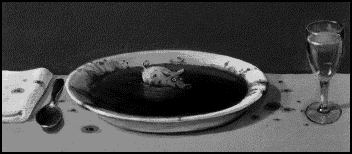 But what will get on the film? Film frames are still of the same size they were in the 20's, and their aspect ratio still is 1.37:1 (with the exception of Super-35). Leo P. Old has several different processes to choose from. |
2.1 AnamorphicMr. Old may use anamorphic lenses on his camera. They squeeze the image to fit exactly on the film, as the following picture shows: 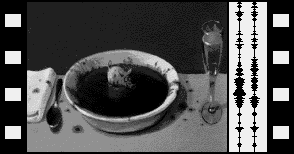 This way Mr. Old gets exactly what he wanted and nothing else. There is one drawback, though. The movie theatre showing the film must naturally also have an anamorphic lens that is able to unsqueeze the image to its original format. Some movies that have used this technique very well are: The Good, the Bad and the Ugly, Star Wars (all of them), and The Pink Panther Strikes Again. |
2.2 Hard MattingIf Mr. Old can't afford the anamorphic lenses or thinks they restrict his artistical freedom, he might use hard matting to shoot his film. He masks off the top and bottom of the camera image and shoots an image on film with black bars at the top and bottom: 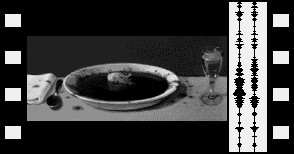 This way too Mr. Old gets only what he wanted the audience to see. There is one drawback here, too: 40% of the film is never used, and that could be considered a waste of resolution. Note: |
2.3 Soft MattingBut perhaps our friend Leo P. Old doesn't have such high artistic goals, yet he dreams to sell millions of copies of his film on video. Then he might use soft matting. With this process, he just shoots through a camera that exposes a full frame of film although the cameraman and Mr. Old only see the 2.35:1 area of the image: 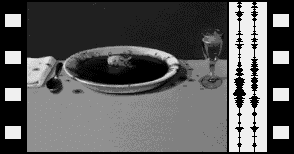 Mr. Old knows that most of the video watchers don't give a damn if occasional mikrophones or other defects can be seen in the later video version, as long as they don't have to deal with "those stupid black bars". Currently, soft-matting is the most used shooting process in the USA. Some movies that have used this technique are: Spaceballs, Silence of the Lambs, Total Recall, Edward Scissorhands. |
2.4 Super-35If Mr. Old uses Super-35, his name very well may be James Cameron. Super-35 is like normal 35 mm film, but the optical audio tracks (that are of low quality anyway) have given away to a somewhat wider picture with an aspect ratio of roughly 1.6:1. Mr. Old again only see the 2.35:1 area of the picture, but much more is stored on film: 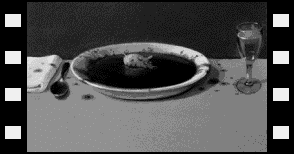 Mr. Old wants to have some more stuff on the film so that he can make a good full-screen video transfer out of it. Some movies that have used this technique are: Abyss, Terminator 2, True Lies, Apollo 13. |
3. Speed Problems with TransfersBefore concentrating on getting a video version done of films shot with different widescreen processes, we have to think a little about one even more basic thing: playing speed. With very few exceptions, films run with a speed of 24 fps (frames per second). However, NTSC video runs at 30 fps and PAL video at 25 fps. These facts might look quite distressing, but they aren't that bad. Fortunately a frame is not the smallest unit of video timing. The smallest unit is a field, where half of the scanlines of the video system are shown. NTSC has 60 fields/s and PAL has 50 fields/s. |
3.1 PALLet's begin with PAL, because the video conversion is more straightforward with it. As the movie frame rate is 24 fps and PAL frame rate is 25 fps, it is very easy to just let the movie play 4% too fast and that way achieve sync between film and video. This makes movies last 2m24s less for every hour of the original film, and it makes all voices almost a halftone higher. Although this is considered to be harmful to music by some people, most people don't notice anything. I found watching one my favourite movies, Pink Floyd's The Wall, to be painful on PAL video because the songs were out of tune and too fast. Otherwise I haven't had problems with the wrong speed of PAL video. |
3.2 NTSCWith NTSC the speed problem has to be solved differently: 30 fps and 24 fps don't mix very well. However, if we remember that NTSC has 60 fields/s, you might also notice that 5 fields take 5/60s = 1/12s time, which is exactly the amount it takes for a film to show two frames. So here's what we do: We take the first film frame, and show it for 3 NTSC fields, i.e. 3/60s. Then we take the second film frame, and show it for 2 NTSC fields, i.e. 2/60s. The total time for the original film should be 2/24s = 1/12s, which is exactly the same it took for NTSC to show the same frames (3/30s+2/60s = 5/60s = 1/12s). The problem with this is, that every other film frame is shown for 1/20s, while every other is shown for 1/30s. That makes pans look less smooth than what they did in the movie theatre, or PAL video for that matter. This also leads to the fact that if you have an NTSC VCR with frame advance, you'll see duplicate frames from time to time. With 12" laserdiscs this problem is solved by putting so-called white line codes on the discs that tells the player when a new film frame has begun. Note: |
3.3 Combined FigureThe following figure shows how the conversion from film frames to video fields is done.
|
4. Different Processes to VideoAs we know, there are several ways in which a film can be shot. Let's now have a look in how that movie can then be transferred to home video. |
4.1 Flat, or Full-FrameAlmost everything shot for television is shot flat for the TV aspect ratio, 1.33:1. Making a video version of a film like The Wrong Trousers is thus very easy: Just transfer it. The only problems come if you have a new, 16:9 television set (1.78:1). Then you have to make the choice: do you want the full image, albeit smaller, or do you want to fill your whole screen, and lose some information. Choose yourself! 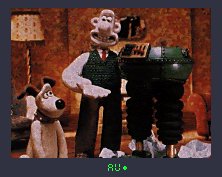
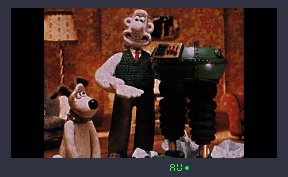
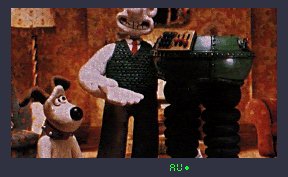 |
4.2 Anamorphic or Hard MatteThis is the toughest one. Here a decision must be made, because there is no easy way to transfer the film to video without losing information. The film can be transferred as it is, leaving black bars at the top and bottom of the picture. This is called letterboxing. On new 16:9 television sets the visible black bars are much smaller even for a very wide film like this (with an aspect ratio of 1:2.35). 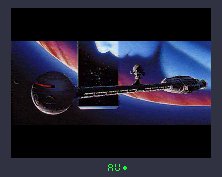
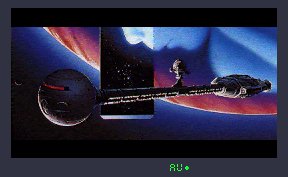 Some people tend to think letterboxing makes their little TV sets seem even smaller, and they hate it for that. That's why almost all widescreen movies have been made to fill the little TV screen with one way or another. A simple way to make an anamorphic film fit on a TV set is to just leave the anamorphic lense out, and everything in the original picture is stored on video. Unfortunately, all people become thin and distorted, but this has been done, and still is, from time to time. Actually, Philips' CD-I depends on a 10% distortion in aspect ratios to make CD-I both NTSC and PAL compatible. The effect is just too horrible to show you, so I won't do it. Another way is to focus the video camera on the center of the film screen, and show you the centre of the movie. This is called cropping, and it isn't such a great idea, because you'll miss everything happening in the side ends of the picture, and may become totally clueless when, say, an empty table talks by itself. The mostly common way to solve the problem of anamorphic films is the so-called panning and scanning. The person responsible for film to video transfer is able to show you any part of the screen. This way he may let you concentrate on the action with the price of not letting you see anything that person has thought was unnecessary. Be aware, that with a movie shot in 2.35:1 and shown pan & scan full screen, you'll lose over 40% of the original picture area. Some movies don't suffer too much (Pink Floyd's The Wall) while other become totally inwatchable (The Good, the Bad and the Ugly). Here is an example of a pan & scan picture: 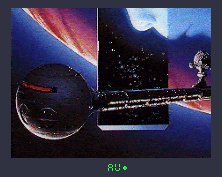 In some countries, like Finland, the subtitles appear superimposed over the picture, which makes the watcher lose more than 50% of the original picture area. The worst scenario I have seen was someone watching a pan & scan transfer of a film on a 16:9 television set. In this scenario the watcher loses 57% of the original picture area, so there really is not much left of the original cinematography: 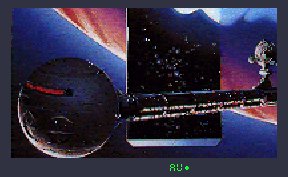 And take my word for this: The subtitles on that film took 1/4 of what was left, and I just left laughing. If you want to know more about letterboxing widescreen films, MGM's Letterbox Page is extremely useful. Also some good examples of how Pan & Scan differs from full letterboxed widescreen can be seen at The Letterbox Advocacy Page. |
4.3 Soft MatteA soft-matted film was originally shot in an aspect ratio of 1.33:1, but with the original aspect ratio in mind, in this case 2.35:1. On video, the film can be either shown open-matted or letterboxed: 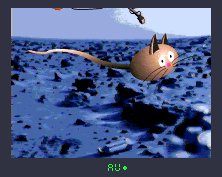
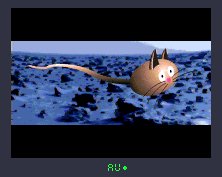 Here it seems that we really lose with the letterbox version: There is clearly more information on the top and bottom of the screen in the open matted version. Unfortunately this extraneous information is also the problem of opening the mattes. The areas now opened for the viewer can't have important new information compared to the letterboxed release, because the director was only looking at the widescreen area shots when he was making the movie. There also may be some unwanted information present in the opened matte like in my example picture: a microphone at the top of the picture and a Coke-bottle at the bottom of the Enchanted Sea. If you want to have a good look at problems with open mattes, have a look at the PAL version of Total Recall. Also, special effects are usually shot or calculated only for the widescreen part of the movie (typically around 2:1), so in scenes with special effects a full-screen version of an open matte movie is panned & scanned just like an anamorphic or hard-matted movie. This can clearly be seen in T2 or the Back to the Future -movies. |
4.4 Super-35This chapter could be called J. Cameron, because it essentially tells what he does with this novel film format. The film is first shot with the original theatrical aspect ratio 2.35:1 in mind. After that, Mr. Cameron transfers the whole movie from the original Super-35 film to a high-resolution digital format. From that it is fairly easy to extract the theatrical widescreen version, as well as a special pan & scan version. Let's have a look at an original Super 35-frame: 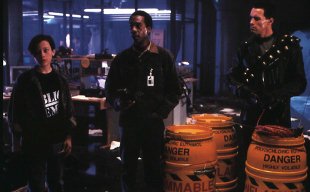 Then let's have a look at how the widescreen and pan & scan versions are extracted from that frame: 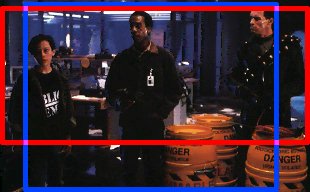 The red square indicates the widescreen area, which is naturally the same all the time, and which was visible to the cameraman. The blue pan & scan area, however, can move in any direction and can change in size, too. This means that while in the example the pan & scan version offers more vertical information and loses little horizontal information, that is not always the case. Sometimes Cameron zooms in the picture to better highlight the point he is wanting to make. Mr. Cameron takes the time to do the pan & scan version himself. He has even said that for home video purposes he prefers his p&s version of Abyss over the WS one. However, if one wants to see a movie like it was shown at the movies, the widescreen version is the way to go. Here are example pictures of both the widescreen and pan & scan versions: 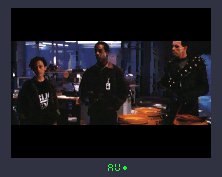
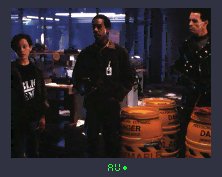 Although J. Cameron has taken much time to make the pan & scan version as perfect as possible, there still are some defects present. For instance, in T2, when T-800 and John are going to the telephone booth, you can clearly see in the p&s version that the telephone has been broken all the time and that T-800 only breaks some sort of plastic cover that stops the money from falling to the ground. Also it must be noted, that all special effects were shot with an aspect ratio of 2.1:1, and those must naturally be severly panned & scanned. |
Originally Created: 04/17/97 | ||||||